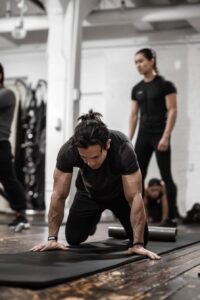If you’re just starting a workout routine for the first time or coming back to the gym after a short break, you’ll likely be stiff and sore after your first workout. Over time your body gets used to exercising, but every now and again you might feel sore from hitting the gym.
Some people chase that feeling of soreness in every workout. Others can’t stand the feeling and would like to be able to walk normally in the days following their workout.
What causes soreness isn’t fully understood. The proper term for it is “delayed-onset muscle soreness,” which is a fancy term for the soreness you feel after a workout. It’s called delayed-onset because it usually takes 24-48 hours after a workout to really feel the stiffness.
The pain you feel from soreness is caused primarily by inflammation. For a while, it was thought that micro-tears in the muscle were the culprit. When you work out, your muscles are strained like a rope during tug-of-war. They often suffer from microscopic tears that your body then has to heal.
Inflammation is your body’s way of healing. It’s an immune response that tells the body to send more blood and nutrients to the injured area, helping it heal faster. Just like when you twist an ankle or have surgery, the injury itself isn’t necessarily the most painful thing. It’s the inflammation after the injury that hurts.
While inflammation is the cause of muscle soreness, micro-tears might not be the cause of inflammation. Researchers have found that mice who work out but don’t sustain tears in the muscle can still have inflammation. There’s some evidence that growth factors, which tell your body to grow new nerves and muscle, could be the cause of inflammation. Your body will produce these growth factors after a workout to trigger your muscle to grow and adapt.
Soreness is often caused by doing something new. That can mean working out after taking a break (any exercise will be relatively new to the body), trying a new exercise, or doing a different style of workout.
Research shows that it’s more so the eccentric, not concentric portion of a movement that will make you sore. When you squat, as you lower yourself down into the bottom of the squat position, you’re doing an eccentric contraction. As you stand up, you’re doing a concentric contraction. An easy way to remember is that eccentric means you’re going down and concentric means you’re moving up.
Another interesting finding is that if you do similar workouts your body will protect itself against inflammation and soreness. That doesn’t mean the workout isn’t beneficial, it simply means that your body is blunting the feeling of soreness.


